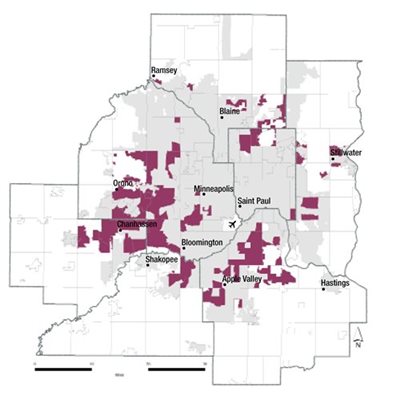 With some exceptions, Type G tracts were mostly outside the I-494 and I-694 ring, in the exurban parts of the study area in communities such as Shoreview, Lino Lakes, Plymouth, Minnetonka, Savage, Shakopee, Prior Lake, Apple Valley, Rosemount, Lake Elmo and Stillwater. Most of these tracts had or were near natural amenities such as lakes, parks and other bodies of water.
With some exceptions, Type G tracts were mostly outside the I-494 and I-694 ring, in the exurban parts of the study area in communities such as Shoreview, Lino Lakes, Plymouth, Minnetonka, Savage, Shakopee, Prior Lake, Apple Valley, Rosemount, Lake Elmo and Stillwater. Most of these tracts had or were near natural amenities such as lakes, parks and other bodies of water.
Built environment trends and demographic dynamics were the main factors that changed Type G tracts. Their development patterns and their age and income characteristics made them stand out among other types.
Type G tracts experienced strong construction activity and development remained above the study area levels during the 1990s. The share of recently built housing stock was especially high—the second highest in the study area—in 2000, suggesting that most of the construction activity in Type G took place during the 1990s. While this share dipped below the study area median from 2000 to 2010, significant construction activity took place during the 2000s, although at a slower pace than in the 1990s. Between 2010 and 2017, in the post-recession period, construction activity in Type G tracts almost came to a complete halt as it did in the rest of the study area.
The age profile of Type G tracts was closely aligned with the development patterns in these areas. The share of school-age children peaked in 2000 after the big burst of development during the 1990s, suggesting that most of the population growth during that time came from the inflow of families with school-age children. A similar but somewhat slower pattern of growth occurred during the 2000s: the inflow of families with school-age children fueled growth but at a slower rate. The share of school-age children in Type G tracts continued to decline as development dropped to almost nothing during the 2010s. Despite this overall decline, however, Type G areas continued to have some of the highest shares of school-age children in the study area.
Type G tracts also stood out in terms of their income. Overall, these tracts were the study area’s most affluent tracts; their median household incomes remained the highest in the study area at all three time points. Even after the sharp declines in median household incomes during the 2000s, median household incomes in Type G tracts remained well above the study area medians. Racially, Type G tracts remained predominantly white. In fact, these tracts had the lowest percentages of people of color among all types at all three time points. These areas also experienced the smallest increase in racial diversity during the study period.
Type G tracts continued to have the most expensive housing stock throughout the study period. Housing markets fully recovered from the recession; in fact, median home values in 2017 exceeded the pre-recession values. Median gross rents in these areas remained the highest in the study area and rents started increasing after a sharp decline during the recession. These tracts continued to have the lowest share of rental units in the study area.